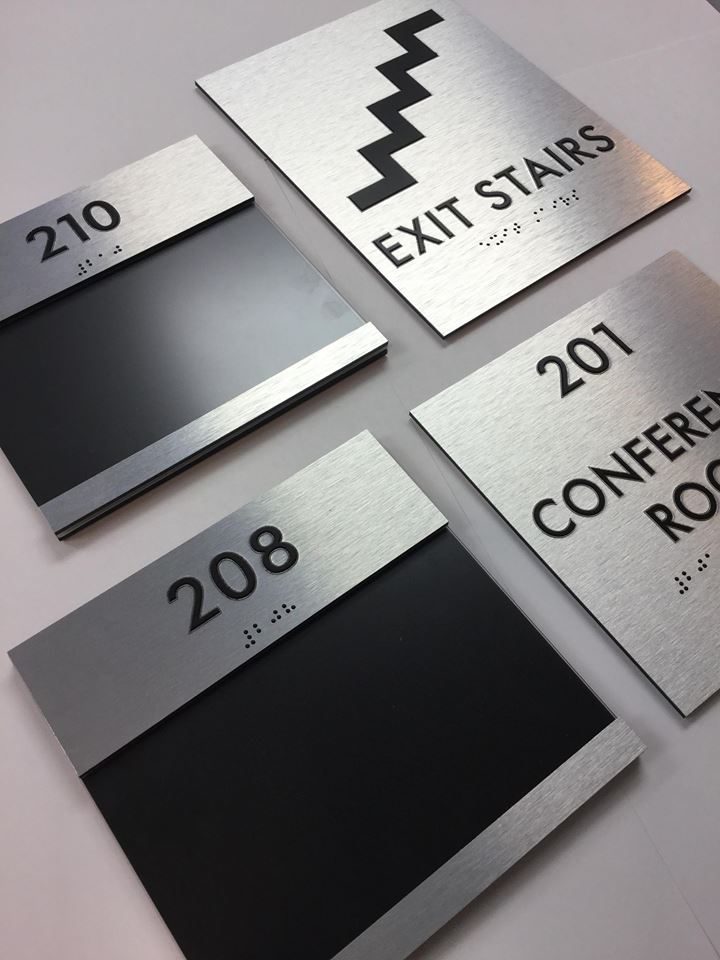A Comprehensive Guide to Picking the Right ADA Signs
A Comprehensive Guide to Picking the Right ADA Signs
Blog Article
Checking Out the Secret Functions of ADA Indicators for Enhanced Availability
In the world of access, ADA indicators act as silent yet effective allies, guaranteeing that areas are inclusive and accessible for people with disabilities. By incorporating Braille and responsive elements, these signs break obstacles for the aesthetically impaired, while high-contrast color pattern and legible typefaces provide to diverse visual demands. In addition, their critical positioning is not arbitrary yet instead a calculated effort to promote seamless navigation. Yet, past these attributes exists a much deeper story regarding the development of inclusivity and the recurring commitment to producing equitable areas. What much more could these indications signify in our search of universal ease of access?
Importance of ADA Compliance
Making certain compliance with the Americans with Disabilities Act (ADA) is essential for cultivating inclusivity and equivalent access in public areas and workplaces. The ADA, enacted in 1990, mandates that all public facilities, employers, and transportation services fit individuals with impairments, guaranteeing they appreciate the same legal rights and chances as others. Conformity with ADA criteria not just satisfies lawful obligations however likewise enhances a company's credibility by demonstrating its dedication to diversity and inclusivity.
Among the crucial elements of ADA compliance is the application of accessible signs. ADA signs are designed to ensure that people with disabilities can easily browse with spaces and buildings. These indicators need to stick to details standards pertaining to size, font style, shade contrast, and positioning to ensure exposure and readability for all. Correctly implemented ADA signage aids remove obstacles that individuals with disabilities typically encounter, therefore promoting their self-reliance and confidence (ADA Signs).
Furthermore, adhering to ADA laws can minimize the threat of lawful repercussions and potential penalties. Organizations that fail to adhere to ADA guidelines may deal with charges or lawsuits, which can be both economically troublesome and destructive to their public image. Therefore, ADA compliance is important to fostering a fair environment for everybody.
Braille and Tactile Components
The unification of Braille and responsive aspects into ADA signs personifies the principles of availability and inclusivity. It is typically placed below the matching text on signage to make sure that individuals can access the info without aesthetic help.
Responsive components prolong beyond Braille and consist of elevated personalities and icons. These components are made to be discernible by touch, enabling individuals to recognize area numbers, toilets, leaves, and various other important areas. The ADA establishes details standards relating to the size, spacing, and positioning of these tactile elements to maximize readability and make certain consistency across various atmospheres.

High-Contrast Color Design
High-contrast color schemes play a crucial function in enhancing the presence and readability of ADA signage for individuals with aesthetic disabilities. These schemes are vital as they make the most of the distinction in light reflectance between message and background, guaranteeing that signs are quickly discernible, even from a range. The Americans with Disabilities Act (ADA) mandates the usage of specific shade contrasts to accommodate those with restricted vision, making it a vital aspect of conformity.
The efficiency of high-contrast colors hinges on their ability to stand apart in different lights conditions, consisting of dimly lit atmospheres and locations with glare. Commonly, dark text on a light background or light text on a dark history is employed to attain ideal comparison. Black text on a white or yellow history gives a stark visual distinction that helps in fast acknowledgment and comprehension.

Legible Fonts and Text Size
When taking into consideration the design of ADA signage, the choice of legible fonts and appropriate message dimension can not be overemphasized. The Americans with Disabilities Act (ADA) mandates that font styles should be not italic and sans-serif, oblique, manuscript, extremely ornamental, or of this hyperlink unusual form.
According to ADA standards, the minimal message height need to be 5/8 inch, and it must enhance proportionally with watching distance. Consistency in text dimension contributes to a natural visual experience, assisting individuals in browsing atmospheres efficiently.
In addition, spacing between lines and letters is essential to readability. Appropriate spacing avoids personalities from appearing crowded, boosting readability. By sticking to these requirements, designers can considerably enhance ease of access, making sure that signs serves its desired purpose for all people, despite their visual capacities.
Reliable Positioning Techniques
Strategic positioning of ADA signs is essential for taking full advantage of availability and making sure compliance with legal standards. ADA standards specify that indicators must be placed at a height between 48 to 60 inches from the ground to guarantee they are within the line of view for both standing and seated people.
Furthermore, signs have to be put surrounding to the lock side of doors to allow very easy identification prior to entrance. Uniformity in indication placement throughout a center enhances predictability, lowering confusion and boosting overall user experience.

Conclusion
ADA indications play a crucial duty in advertising access by incorporating attributes that resolve the demands of people with handicaps. These aspects jointly promote special info an inclusive atmosphere, underscoring the value of ADA conformity in making sure equal access for all.
In the realm of accessibility, ADA indicators offer as quiet yet powerful allies, guaranteeing that areas are comprehensive and accessible click for info for individuals with impairments. The ADA, enacted in 1990, mandates that all public facilities, companies, and transport services accommodate people with specials needs, ensuring they delight in the same civil liberties and chances as others. ADA Signs. ADA indications are designed to ensure that people with handicaps can easily browse with spaces and buildings. ADA guidelines specify that indications ought to be installed at a height in between 48 to 60 inches from the ground to ensure they are within the line of sight for both standing and seated people.ADA indicators play a vital duty in promoting accessibility by incorporating functions that resolve the requirements of people with specials needs
Report this page